<Back to Index>
- Chemist and Physicist Ernest Rutherford, 1871
- Radiochemist Frederick Soddy, 1877
PAGE SPONSOR
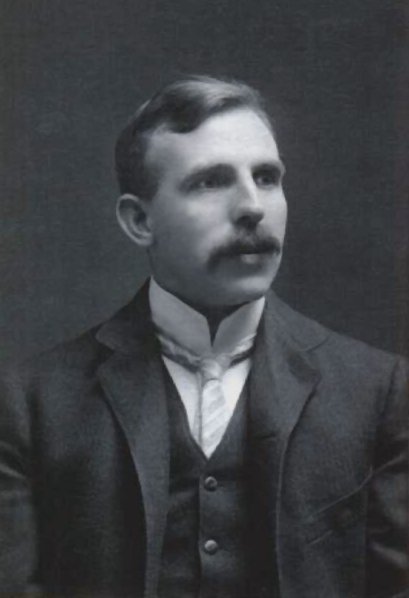
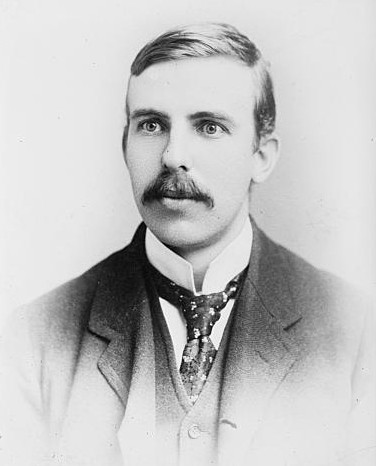
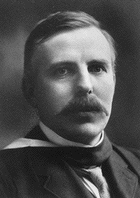
Ernest Rutherford, 1st Baron Rutherford of Nelson OM, FRS (30 August 1871 – 19 October 1937) was a New Zealand - British chemist and physicist who became known as the father of nuclear physics. In early work he discovered the concept of radioactive half life, proved that radioactivity involved the transmutation of one chemical element to another, and also differentiated and named alpha and beta radiation, proving that the former was essentially helium ions. This work was done at McGill University in Canada. It is the basis for the Nobel Prize in Chemistry he was awarded in 1908 "for his investigations into the disintegration of the elements, and the chemistry of radioactive substances".
Rutherford performed his most famous work after he had moved to the Victoria University of Manchester
in the UK in 1907 and was already a Nobel laureate. In 1911, he
theorized that atoms have their positive charge concentrated in a very
small nucleus, and thereby pioneered the Rutherford model of the atom,
through his discovery and interpretation of Rutherford scattering in his
gold foil experiment. He is widely credited with first "splitting the
atom" in 1917 in a nuclear reaction between nitrogen and alpha
particles, in which he also discovered (and named) the proton.
This led to the first experiment to split the nucleus in a fully
controlled manner, performed by two students working under his
direction, John Cockcroft and Ernest Walton, in 1932. After his death in
1937, he was honored by being interred with the greatest scientists of
the United Kingdom, near Sir Isaac Newton's tomb in Westminster Abbey. The chemical element rutherfordium (element 104) was named after him in 1997.
Ernest Rutherford was the son of James Rutherford, a farmer, and his wife Martha Thompson, originally from Hornchurch, Essex, England. James had emigrated to New Zealand from Perth, Scotland, "to raise a little flax and a lot of children". Ernest was born at Spring Grove (now Brightwater), near Nelson, New Zealand. His first name was mistakenly spelled Earnest when his birth was registered.
He studied at Havelock School and then Nelson College and won a scholarship to study at Canterbury College, University of New Zealand where he was president of the debating society, among other things. After gaining his BA, MA and BSc, and doing two years of research at the forefront of electrical technology, in 1895 Rutherford traveled to England for postgraduate study at the Cavendish Laboratory, University of Cambridge (1895 – 1898), and he briefly held the world record for the distance over which electromagnetic waves could be detected.
In 1898 Rutherford was appointed to succeed Hugh Longbourne Callendar
in the chair of Macdonald Professor of physics at McGill University in
Montreal, Canada, where he did the work that gained him the Nobel Prize
in Chemistry in 1908. In 1900 he gained a DSc
from the University of New Zealand. Also in 1900 he married Mary
Georgina Newton (1876 – 1945); they had one daughter, Eileen Mary
(1901 – 1930), who married Ralph Fowler. In 1907 Rutherford moved to Britain to take the chair of physics at the University of Manchester.
He was knighted in 1914. In 1916 he was awarded the Hector Memorial Medal. In 1919 he returned to the Cavendish as Director. Under him, Nobel Prizes were awarded to James Chadwick for discovering the neutron (in 1932), John Cockcroft and Ernest Walton for an experiment which was to be known as splitting the atom using a particle accelerator, and Edward Appleton for demonstrating the existence of the ionosphere. He was admitted to the Order of Merit in 1925 and raised to the peerage as Baron Rutherford of Nelson, of Cambridge in the County of Cambridge, in 1931, a title that became extinct upon his unexpected death in 1937.
For some time beforehand, Rutherford had a small hernia, which he had
neglected to have fixed, and it became strangulated, causing him to be
violently ill. Despite an emergency operation in London, he died four
days afterwards of what physicians termed "intestinal paralysis." He was
given the high honor of burial in Westminster Abbey, near Isaac Newton and other illustrious British scientists.
During the investigation of radioactivity he coined the terms alpha ray and beta ray in 1899 to describe the two distinct types of radiation emitted by thorium and uranium. These rays were differentiated on the basis of penetrating power. From 1900 to 1903 he was joined at McGill by the young Frederick Soddy (Nobel Prize in Chemistry, 1921) and they collaborated on research into the transmutation of elements. Rutherford had demonstrated that radioactivity was the spontaneous disintegration of atoms. He noticed that a sample of radioactive material invariably took the same amount of time for half the sample to decay — its "half - life" — and created a practical application using this constant rate of decay as a clock, which could then be used to help determine the age of the Earth, which turned out to be much older than most of the scientists at the time believed.
In 1903, Rutherford considered a type of radiation discovered (but not named) by French chemist Paul Villard in 1900 as an emission from radium, and realized that this observation must represent something different from alpha rays and beta rays, due to its very much greater penetrating power. Rutherford gave this third type of radiation its name also: the gamma ray.
In Manchester he continued to work with alpha radiation. In
conjunction with Hans Geiger he developed zinc sulfide scintillation
screens
and ionization chambers to count alphas. By dividing the total charge
they produced by the number counted, Rutherford decided that the charge
on the alpha was two. In late 1907 Ernest Rutherford and Thomas Royds
allowed alphas to penetrate a very thin window into an evacuated tube.
As they sparked the tube into discharge,
the spectrum obtained from it changed, as the alphas accumulated in the
tube. Eventually, the clear spectrum of helium gas appeared, proving
that alphas were at least ionized helium atoms, and probably helium
nuclei.
Rutherford remains the only science Nobel Prize winner to have performed his most famous work after receiving the prize. Along with Hans Geiger and Ernest Marsden in 1909 he carried out the Geiger – Marsden experiment, which demonstrated the nuclear nature of atoms. Rutherford was inspired to ask Geiger and Marsden in this experiment to look for alpha particles with very high deflection angles, of a type not expected from any theory of matter at that time. Such deflections, though rare, were found, and proved to be a smooth but high order function of the deflection angle. It was Rutherford's interpretation of this data that led him to formulate the Rutherford model of the atom in 1911 — that a very small positively charged nucleus was orbited by electrons.
Before leaving Manchester in 1919 to take over the Cavendish laboratory in Cambridge, Rutherford became in 1917 the first person to deliberately transmute one element into another, when he converted nitrogen into oxygen through the nuclear reaction 14N + α → 17O + proton. In the products of this reaction he identified hydrogen nuclei by their similarity to the particle radiation from earlier experiments in which he had bombarded hydrogen gas with alpha particles. This result showed that hydrogen nuclei were a part of nitrogen nuclei (and by inference, probably other nuclei as well). Such a construction had been suspected for many years on the basis of atomic weights which were whole numbers of that of hydrogen (Prout's hypothesis). Now Rutherford decided that a hydrogen nucleus was a fundamental building block and a particle, which he named the proton.
In 1921, while working with Niels Bohr (who postulated that electrons
moved in specific orbits), Rutherford theorized about the existence of
neutrons, which could somehow compensate for the repelling effect of the
positive charges of protons by causing an attractive nuclear force and
thus keeping the nuclei from breaking apart. Rutherford's theory of
neutrons was proved in 1932 by his associate James Chadwick, who in 1935
was awarded the Nobel Prize in Physics for this discovery.
Rutherford's research, and work done under him as laboratory director, established the nuclear structure of the atom and the essential nature of radioactive decay. Rutherford's team also demonstrated artificially induced nuclear transmutation. He is known as the father of nuclear physics. Rutherford died too early to see Leó Szilárd's idea of controlled nuclear chain reactions come into being. However, a speech of Rutherford's about artificially induced transmutation printed in the September 12, 1933 London paper The Times is reported by Szilárd to have been his inspiration for thinking of the possibility of a controlled nuclear chain reaction, in London, on the same day.
Rutherford's speech touched on the 1932 work of his students John Cockcroft and Ernest Walton in "splitting" lithium into alpha particles by bombardment with protons from a particle accelerator they had constructed. Rutherford realized that the energy released from the split lithium atoms was enormous, but he also realized that the energy needed for the accelerator, and its essential inefficiency in splitting atoms in this fashion, made the project an impossibility as a practical source of energy (accelerator - induced fission of light elements remains too inefficient to be used in this way, even today). Rutherford's speech in part, read:
- We might in these processes obtain very much more energy than the proton supplied, but on the average we could not expect to obtain energy in this way. It was a very poor and inefficient way of producing energy, and anyone who looked for a source of power in the transformation of the atoms was talking moonshine. But the subject was scientifically interesting because it gave insight into the atoms.
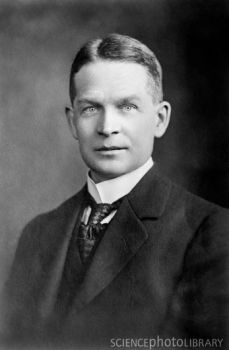
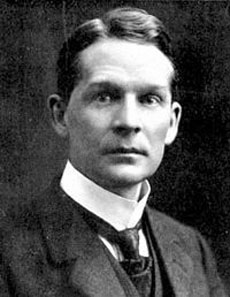
Frederick Soddy (2 September 1877 – 22 September 1956) was an
English radiochemist and monetary economist who explained, with Ernest
Rutherford, that radioactivity is due to the transmutation of elements, now known to involve nuclear reactions. He also proved the existence of isotopes of certain radioactive elements. He received the Nobel Prize for Chemistry in 1921, and has a small crater named for him on the far side of the Moon.
Soddy was born at 6 Bolton Road, Eastbourne, England. He went to school at Eastbourne College, before going on to study at University College of Wales at Aberystwyth and at Merton College, Oxford. He was a researcher at Oxford from 1898 to 1900.
In 1900 he became a demonstrator in chemistry at McGill University in Montreal, Quebec, where he worked with Ernest Rutherford on radioactivity. He and Rutherford realized that the anomalous behavior of radioactive elements was because they decayed into other elements. This decay also produced alpha, beta, and gamma radiation. When radioactivity was first discovered, no one was sure what the cause was. It needed careful work by Soddy and Rutherford to prove that atomic transmutation was in fact occurring.
In 1903, with Sir William Ramsay at University College London, Soddy verified that the decay of radium produced alpha particles composed of positively charged nuclei of helium. In the experiment a sample of radium was enclosed in a thin walled glass envelope sited within an evacuated glass bulb. Alpha particles could pass through the thin glass wall but were contained within the surrounding glass envelope. After leaving the experiment running for a long period of time a spectral analysis of the contents of the former evacuated space revealed the presence of helium. This element had recently been discovered in the solar spectrum by Bunsen and Kirchoff.
From 1904 to 1914, Soddy was a lecturer at the University of Glasgow and while there he showed that uranium decays to radium. It was here also that he showed that a radioactive element may have more than one atomic mass though the chemical properties are identical. He named this concept isotope meaning 'same place' - the word 'isotope' was initially suggested to him by Margaret Todd. Later, J.J. Thomson showed that non - radioactive elements can also have multiple isotopes. Soddy also showed that an atom moves lower in atomic number by two places on alpha emission, higher by one place on beta emission. This was a fundamental step toward understanding the relationships among families of radioactive elements. Soddy published The Interpretation of Radium (1909) and Atomic Transmutation (1953). In May 1910 he was elected a Fellow of the Royal Society
In 1914 he was appointed to a chair at the University of Aberdeen, where he worked on research related to World War I. In 1919 he moved to Oxford University as Dr Lee's Professor of Chemistry, where, in the period up till 1936, he reorganized the laboratories and the syllabus in chemistry. He received the 1921 Nobel Prize in chemistry for his research in radioactive decay and particularly for his formulation of the theory of isotopes.
His work and essays popularizing the new understanding of radioactivity was the main inspiration for H. G. Wells's The World Set Free (1914), which features atomic bombs dropped from biplanes in a war set many years in the future. Wells's novel is also known as The Last War and imagines a peaceful world emerging from the chaos. In Wealth, Virtual Wealth and Debt Soddy praises Wells’s The World Set Free. He also says that radioactive processes probably power the stars.
In four books written from 1921 to 1934, Soddy carried on a "quixotic campaign for a radical restructuring of global monetary relationships", offering a perspective on economics rooted in physics — the laws of thermodynamics, in particular — and was "roundly dismissed as a crank". While most of his proposals - "to abandon the gold standard, let international exchange rates float, use federal surpluses and deficits as macroeconomic policy tools that could counter cyclical trends, and establish bureaus of economic statistics (including a consumer price index) in order to facilitate this effort" - are now conventional practice, his critique of fractional - reserve banking still "remains outside the bounds of conventional wisdom". Soddy wrote that financial debts grew exponentially at compound interest but the real economy was based on exhaustible stocks of fossil fuels. Energy obtained from the fossil fuels could not be used again. This criticism of economic growth is echoed by his intellectual heirs in the now emergent field of ecological economics.
He rediscovered the Descartes' theorem in 1936 and published it as a poem. The kissing circles in this problem are sometimes known as Soddy circles.
Soddy married Winifred Beilby, the daughter of Sir George Beilby, in 1908. He died in Brighton, England in 1956.
The lunar crater Soddy is named after him, as is the uranium compound Soddyite, found in the Democratic Republic of Congo.